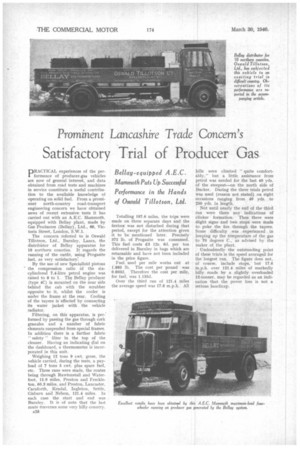Prominent Lancashire Trade Concern's
Page 38

If you've noticed an error in this article please click here to report it so we can fix it.
Satisfactory Trial of Producer Gas
Bellay-equipped A.E.C. Mammoth Puts Up Successful Performance in the Hands of Oswald Tillotson, Ltd. DRACTICAL experiences of the per1 formance of producer-gas vehicles are now of general interest, and data obtained from road tests and machines in service constitute a useful contribution to the available knowledge of operating on solid fuel. From a prominent north-country road-transport engineering concern we have obtained news of recent extensive tests it has carried out with an A.E.C. Mammoth. equipped with Bellay plant, made by Gas Producers (Bellay), Ltd., 66, Victoria Street, London, S.W.I.
The concern referred to is Oswald Tillotson, Ltd., Burnley, Lancs, the distributor of Bellay apparatus for 10 northern counties. It regards the running of the outfit, using Progasite fuel, as very satisfactory:
By the use of new Specialloid pistons the compression ratio Of the sixcylinderecl 7.4-litre petrol engine was raised to 8 to I. The Bellay producer (type 4C) is mounted on the near side behind the cab with the scrubber opposite to it, whilst the cooler is under the frame at the rear. Cooling of the tnyere is effected by connecting its water jacket with the vehicle radiator.
Filtering, on this apparatus, is pen' formed by passing the gas through cork granules and a number of fabric elements suspended from special frames. In addition there is a further fabric " safety " filter in the top of the cleaner. Having an indicating dial on the dashboard, a thermometer is incorporated in this unit.
Weighing 12 tons 9 cwt. gross, the vehicle carried, during the tests, a payload of 7 tons 5 cwt. plus spare fuel, etc. Three runs were made, the routes being through Rawtenstall and Waterfoot, 15.9 miles, Preston and Freckleton, 60.3 miles, and Preston, Lancaster, Carnforth, Kendal, Ingleton, Settle, Gisburn and Nelson, 121.4 miles. In each case the start and end was Burnley. It is of note that the last route traverses some very hilly country.
A28
Totalling 197.6 miles, the trips were made on three separate days and the firebox was not disturbed during that period, except for the attention given it to be mentioned later. Precisely 372 lb. of Progasite was consumed. This fuel costs £5 12s. 6d. per ton delivered in Burnley in bags which are returnable and have not been included in the price figure.
Fuel used per mile works out at 1..883 lb. The cost per pound was 0.603d. Therefore the cost per mile, for fuel, was 1.135d.
Over the third run of 121.4 miles the average speed was 17.6 M.p.h. All
hills were climbed " quite comfortably," but a little assistance from petrol was needed for the last 40 yds. of the steepest—on the north side of Bucker. During the three trials petrol was used (reason not stated) on eight occasions ranging from 40 yds. to 250 yds. in length.
Not until nearly the eirel of the third run were there any indications of clinker formation. Then there were slight signs and two stops were Made to poke the fire through the tuyere. Some difficulty was experienced in keeping up the temperature of the gas to 70 degrees C„ as advised by the maker of the plant.
Undoubtedly the outstanding point of these trials is the speed averaged for the longest run. The figure does not, of course, include stops, but 17,6 m.p.h. over 121.4 miles of markedly hilly roads by a slightly overloaded 12-tonner, may be regarded as an indication that the power loss is not a serious handicap.




























































